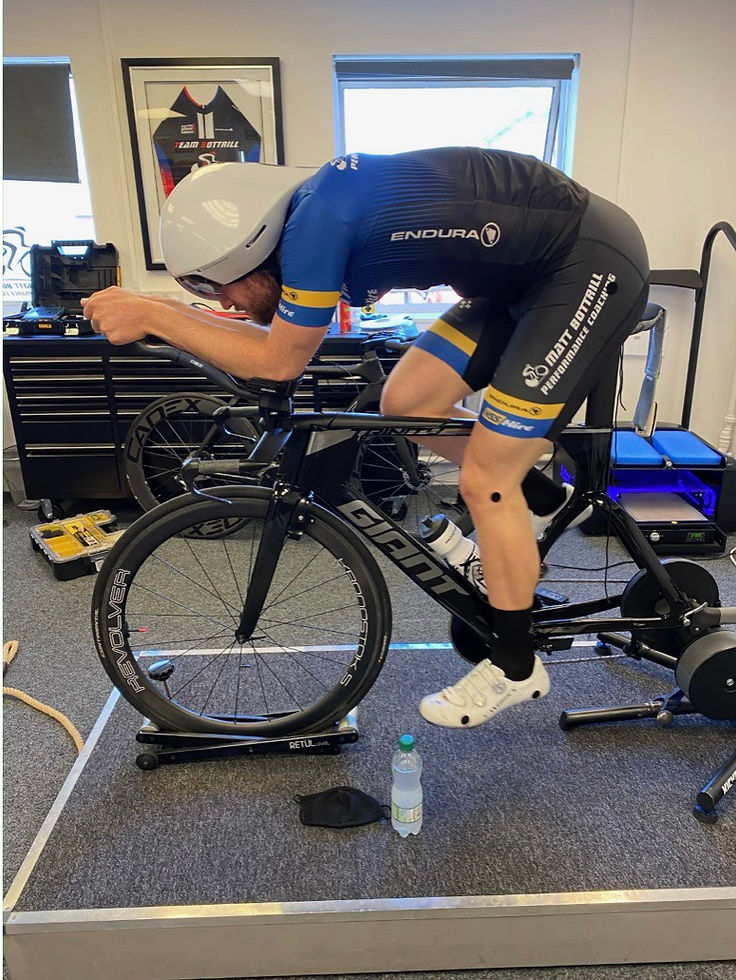
The continuous search for aero perfection
- Matt Bottrill
- Jan 17, 2022
- 5 min read
Updated: Apr 11, 2023
I am by no means an aerodynamicist or bike fitter, but we thought it might be interesting to hear my take on all things aero, particularly as a longer distance time trial specialist. Specifically, I wish to delve into how this impacts my position and how I tailor my training to achieve this.
First things first - yes, the typically more “aggressive”positions aren’t as sustainable for the long distances, but the differences are probably a lot smaller than you might expect if you are set up correctly. My position doesn’t change at all from 10 miles to 12 hours. Why is this? As detailed later, we found that a more relaxed and stretched out shoulder position reduces my frontal area and has the added benefit of allowing my head to drop naturally. Consequently, this means that there is less “squeezing” of the shoulders (more sustainable)involved to achieve a similar outcome.
I have been in the wind tunnel back in 2019, before joining Team Bottrill, and it might surprise people that as a result my set up didn’t change at all (both bike and position). The knowledge I took away from this (equally important) was what didn’t work and also the sensitivity of the head/shoulder position. After starting to work with Matt and Simon in August 2020, it became apparent that my fairly receptible CdA tested in the tunnel did not translate well to the road at all! The shoulder squeeze and low head position were identified as the main culprit due to the fluctuating data, suggesting that the head/shoulder interaction was in fact not sustainable, for over 10 miles never mind 50 or 100miles.
What did I do to fix this? Simply put, I got an aero bike fit from Matt! You might say I’m bias but I’m going to explain why I think it was game changing for me. Armed with the knowledge we’d collected in race data, Matt assessed my position and quite frankly did a complete overhaul of my cockpit! The change was like night and day. What was instantly recognisable was the fact that that I subconsciously found myself locked in the aero position, even on inclines or during interval recoveries!
This reassured me that being aerodynamic doesn’t always have to be uncomfortable, with the caveat that you must put in the work to maintain it. From February to August, I completed 5,500 miles on the TT bike in 2021. I also do a fair bit of off the bike work including strength and conditioning, this is something I’ve learnt the importance of through injury rehabilitation (I bulged a disc in 2015), but it has the added benefit of complimenting time trialling. To me this becomes more apparent when I think about the pedal stoke, the maximum load is achieved towards the middle-end and therefore no matter how much on-bike training you do the main muscle groups aren’t (in my opinion) conditioned well at ‘end point’ (i.e. at the top of the pedal stroke). I’ve thought about this theory during races and when I get fatigued, this poor conditioning becomes more apparent as my hips just give up when tired and can no longer cope with the tight hip angles. Through trial and error, I’ve identified that putting your muscles through a greater load (than that can otherwise be achieved on the bike) at this so called ‘end point’ (for example in a deep squat) provides some insurance for when my legs are heavily fatigued during a race and still having the ability and condition to keep locked in. A caveat to this is that it can sometimes be difficult to manage DOMS and, therefore, most of the work is undertaken during the dark winter months. I’m sure there are other way to achieve the same goal, for instance low cadence work, but for now this seems to be working for me.
So, you’ve dialled in your position, and you now want to make it the new norm. Whilst there is a plethora of sessions you can do to optimise my aero position, if I’m honest, I never did anything specific. For the long-distance races, my approach in training was that I’d just try and spend longer and longer in the position each time I went out on the bike. Simple? The only problem with this is, you need to be very disciplined and not allow the new norm to be compromised through no visual or objective understanding of your position on the road.
Anyone who knows me well, sees first-hand how my training separates me from a lot of cyclists. I’d say 4 sessions a week on the bike are repetitions of the same “boring” training loop. For northeast riders they’ll know last year this was the A696, which was a very straight, flat and relatively fast road. So much so that I’d get comments that there was a 25mm rut in the road from where I’d worn out the tarmac! The common misconception is that this type of training isn’t enjoyable, however, for me it is. Reducing the variables allows your mind to be constantly occupied on making you go faster for less effort. I occasionally tested this by doing a tempo or sweetspot effort over the same 25 miles section of the road. Only purely down the number of times I trained on this road, this would give me some indication on where I was at with the benefit of the “trump card” up my sleeve - a full equipment set up (i.e. disc wheel, skinsuit, TT helmet). In response to this, you might say that training on the turbo is more effective, whilst this might be true for poor riding conditions in winter, I personally can’t help but feel that there is no replacement for just being outside on the TT bike in terms of enjoyment, feel and bike handling. I actually find it very difficult to hold the aero position on the turbo.

My last piece of advice would be that any intervals harder than sweetspot (e.g. VO2’s or Sprints) should be done on the road bike. Reason being is that the target for these sessions is physiological adaptions rather than being aero per se and the latter can sometimes take away from, meaning it is easy to get into a downwards spiral from not hitting your power numbers etc. For most people, you won’t be doing much less than 20 minutes for a hard effort in a TT race so why practice shorter during training? The obvious exception to this is a team time trial.
There is no one size fits all and what works for me might not work for everyone. In my opinion if you can artificially create your own subconscious feedback loop to give yourself reminders of those areas of weakness that you know and truly believe will make you faster (e.g. for me, light squeeze on end of poles and tuck head), you’ll make massive gains this year in sustaining your position over longer periods.
by Tom Hutchinson











Comments